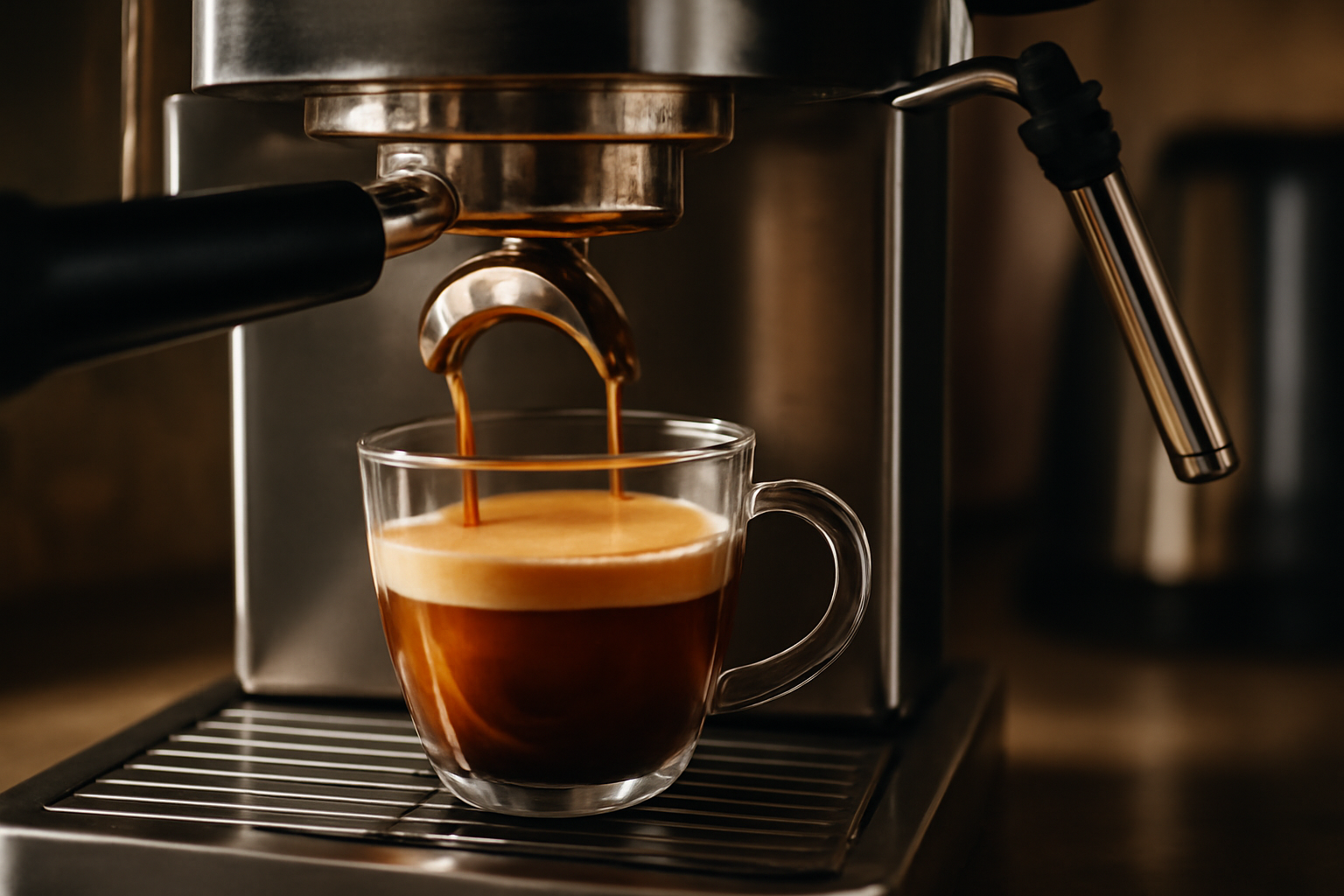Espresso is the heart of coffee culture, a small but powerful shot of concentrated coffee that forms the foundation of many of the world’s most beloved coffee beverages, from lattes to cappuccinos and macchiatos. Brewing the perfect espresso requires skill, precision, and an understanding of the key factors that affect the extraction process. In this guide, we’ll walk you through the essential techniques every barista needs to know to brew the perfect espresso, from understanding your equipment to mastering the art of shot pulling.
1. Understanding Espresso: What Makes It Different?
An espresso is a concentrated coffee beverage brewed by forcing hot water under pressure through finely ground coffee. Unlike drip coffee, which uses gravity to extract flavors, espresso relies on pressure (usually 9 bars) to extract a rich, dense shot of coffee in just 25-30 seconds.
A perfect espresso shot consists of three key components:
- Crema: The golden, frothy layer of foam that sits on top of a well-pulled espresso shot. Crema is a sign of quality espresso and indicates proper extraction.
- Body: The rich, dense, and full texture that gives espresso its strong mouthfeel.
- Heart: The darker, more concentrated liquid that forms the base of the espresso shot. It provides depth and intensity to the flavor.
The key to brewing a perfect espresso is achieving the right balance between these three elements.
2. Choosing the Right Coffee Beans for Espresso
The coffee beans you choose are the foundation of your espresso. While you can use any type of coffee to brew espresso, certain beans are better suited for espresso brewing. The most common choice for espresso is a blend of Arabica and Robusta beans, though you can experiment with single-origin beans to discover unique flavors.
Arabica vs. Robusta
- Arabica Beans: Known for their smooth, complex flavors, Arabica beans are often used in premium espresso blends. They provide a more nuanced taste with floral, fruity, or nutty notes. Arabica beans typically have lower caffeine content than Robusta beans, which can result in a less bitter shot.
- Robusta Beans: Robusta beans have a stronger, bolder flavor and higher caffeine content. These beans create a thicker crema and provide more intense flavor, which can add depth to your espresso shot.
Roasting Level for Espresso
When choosing your beans, the roast level is important. Medium to dark roasts are most commonly used for espresso because they provide the deep, bold flavors associated with espresso. Dark roasts have a rich, roasted taste that pairs well with milk-based drinks, while medium roasts can offer a brighter, more complex flavor profile.
For a well-rounded shot, many espresso blends consist of 70-80% Arabica beans and 20-30% Robusta beans, giving a perfect balance of flavor and crema.
3. Grinding: The Key to Consistent Extraction
One of the most crucial aspects of making espresso is grind size. Espresso requires a fine grind—almost powdered—because the hot water needs to be forced through the coffee quickly. A consistent grind is essential to ensure even extraction and avoid under or over-extraction.
How to Grind for Espresso
A high-quality burr grinder is the best tool for espresso grinding, as it provides a consistent grind size. When grinding your beans for espresso, you should aim for a texture similar to table salt. The grind size is crucial because it determines the rate at which water flows through the coffee grounds, which in turn affects the flavor of your espresso shot.
- Too fine a grind: If the grind is too fine, the water will struggle to pass through the coffee, leading to over-extraction, which produces a bitter and harsh taste.
- Too coarse a grind: If the grind is too coarse, the water will flow through the coffee too quickly, resulting in under-extraction. This causes the espresso to taste weak and sour.
4. Tamping: Creating an Even Coffee Bed
Tamping is the process of compressing the ground coffee evenly into the portafilter before brewing. This is a crucial step, as an uneven tamp can lead to uneven extraction, causing some parts of the coffee to be over-extracted and others under-extracted.
How to Tamp Properly
- Use consistent pressure: Apply 30-40 pounds of pressure when tamping to ensure the coffee grounds are compacted evenly. A consistent, firm tamp creates a smooth, level surface for the water to flow evenly through the grounds.
- Tamp evenly: Ensure the coffee bed is level and free of any air pockets, as this will ensure a uniform extraction.
Tamping too lightly or unevenly will cause water to find an easier path through the coffee, leading to channeling, where the water bypasses parts of the coffee grounds. This results in an under-extracted shot with undesirable flavors.
5. Brewing: The Art of Pulling a Shot
Once you’ve ground your coffee and tamped it evenly, it’s time to pull the shot. The espresso machine uses 9 bars of pressure to force hot water through the coffee grounds. The extraction process should take around 25-30 seconds for the perfect shot.
How to Brew the Perfect Espresso Shot
- Preheat the Machine: Ensure your espresso machine is preheated, including the portafilter and cup. A cold machine can result in poor extraction, as the temperature will fluctuate too much during brewing.
- Check the Pressure: The ideal pressure for espresso brewing is around 9 bars. Most modern espresso machines have pressure gauges that indicate whether the pressure is correct during extraction.
- Timing the Shot: The brewing time for an espresso shot should fall between 25 and 30 seconds. If your shot is pulling too quickly, you may need to adjust the grind size to make it finer. If the shot is pulling too slowly, you may need to make the grind coarser.
- Watch the Crema: As the espresso is brewing, you should see the formation of a golden crema. The crema should have a smooth, velvety texture and should stay intact for several minutes after the shot is pulled.
The Ideal Espresso Shot
A well-pulled espresso shot should have the following characteristics:
- Crema: A golden, smooth foam that sits on top of the shot, lasting for at least 1-2 minutes.
- Body: The espresso should have a rich, full-bodied texture with a slight syrupy consistency.
- Heart: The darker liquid at the bottom of the shot should have an intense, deep flavor.
6. Troubleshooting Common Espresso Problems
Even experienced baristas face challenges when brewing espresso. Here are some common problems and how to fix them:
- Bitter Espresso: If your espresso tastes overly bitter, the grind may be too fine, or the brewing time might be too long. Try coarsening the grind or shortening the extraction time.
- Sour Espresso: If your espresso tastes sour, the grind may be too coarse, or the brewing time might be too short. Try making the grind finer or extending the extraction time.
- Weak Espresso: If your espresso lacks body and depth, the grind may be too coarse, or you may not be using enough coffee. Increase the dose or adjust the grind to be finer.
7. Espresso-Based Drinks: From Espresso to Lattes and More
Espresso serves as the base for many coffee drinks, including lattes, macchiatos, and mochas. Understanding how to brew a perfect espresso is essential for creating these beverages with the right balance of espresso, milk, and foam.
- Latte: A latte consists of one shot of espresso, steamed milk, and a small amount of milk foam on top. The milk to espresso ratio is about 3:1.
- Cappuccino: A cappuccino contains one shot of espresso, steamed milk, and a thick layer of foam. The ratio is roughly 1:1:1 of espresso, steamed milk, and foam.
- Macchiato: A macchiato is a simple espresso shot with just a small amount of foam on top, typically served in a small cup.
Conclusion
Brewing the perfect espresso is an art that combines the right technique, equipment, and knowledge of coffee beans. By understanding the key factors that affect extraction—such as grind size, tamping pressure, and brewing time—you can craft espresso shots that are rich, balanced, and full of flavor. Whether you’re a beginner or an experienced barista, mastering the art of espresso brewing is essential for creating high-quality coffee drinks that will delight your customers or elevate your personal coffee experience at home.

I’m an economist with 15 years of experience in strategic planning and a lifelong passion for wellness and natural living. As a self-learner, I created Herbalife Balance to share insights on healthy eating, mindful habits, and an active lifestyle. Tennis enthusiast and nature lover, I believe in balance as a path to well-being. Through this blog, I help others live healthier, more conscious lives.

